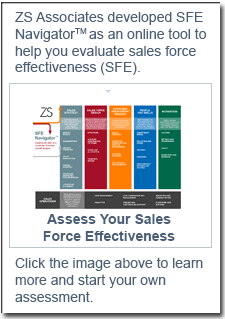The Secret to a Successful Sales Strategy
This is the second article of a seven-part series on sales force effectiveness to be released over the next several months.
What do sales leaders want above all else? Profitable revenue growth. What's the first ingredient required to achieve it? A winning sales strategy. Just one problem: many sales leaders don't know how to develop a winning sales strategy.
 "The term 'sales strategy' hasn't always been defined clearly in the sales profession," says Mike Moorman, Managing Principal at ZS Associates, a global sales and marketing consulting firm. "Essentially, the term is about three basic questions: who is the sales force going to sell to, what are they going to sell to them, and how are they going to sell to them?"
"The term 'sales strategy' hasn't always been defined clearly in the sales profession," says Mike Moorman, Managing Principal at ZS Associates, a global sales and marketing consulting firm. "Essentially, the term is about three basic questions: who is the sales force going to sell to, what are they going to sell to them, and how are they going to sell to them?" In other words, sales strategy is defined as the customer segments that a company targets, its value propositions for each segment, its sales force structure, and its associated selling processes. And although many sales leaders would agree that their strategy needs to be grounded by deep insight into customer needs and buying processes, they often end up chasing strategy with no game plan about how those strategies will tie back to growth.
"Many sales leaders find themselves on a rambling road, trying to define their strategy without a real understanding of the specific growth opportunities they should pursue," says Moorman. "If you haven't wisely defined your mission-critical growth opportunities, you can't devise a laser-sharp sales strategy to go after those opportunities."
Strictly speaking, form must follow function. This leads to a closely related challenge: many sales leaders don't know how to look for their best growth opportunities at a granular enough level to drive sales strategy.
"I ask many sales leaders, 'Where specifically is the growth going to come from to achieve your sales targets?'" says Moorman. "They frequently reply with an answer at the 10,000 foot level: 'We want to grow by 8 percent in marquee and large accounts and by 14 percent in the small- and medium-business segment.' Growth opportunities and priorities defined at this high level provide little help in guiding sales strategy."
To craft a winning sales strategy that will foster profitable growth, start by examining each sales region at a granular level:
- Formulate a granular segmentation of accounts.
- Map the market offerings your organization might sell to each segment.
- Estimate the potential revenue of each product or service (or groupings of products and services) for each segment.
- Determine the breakdown of the potential revenue in terms of up-selling opportunities, cross-selling opportunities, integrated solution opportunities, new account acquisition, and retention.
Estimating potential revenue can be tricky. Moorman advocates a highly scientific approach based on data. A combination of firmographic data, historical sales data, market forecasts, and input from salespeople can be particularly useful when making estimates.
"Sales leaders should use data also to estimate the attractiveness of any given opportunity," says Moorman. "They should look at historical win rates, deal sizes, deal margins, and cycle times, along with win/loss reports, cost-of-sales estimates, customer satisfaction reports, and competitive analysis."
Leveraging data could throw some sales leaders for a loop, especially those used to pursuing sales strategies based on instinct or with little connection to where growth potential actually exists. But if your goal is to use resources on the best opportunities, you should let science drive your strategy.
"Sales leaders who develop strategy based on facts are going to beat those that continue to operate on intuition," says Moorman. "In many markets, there is only so much growth to be had. It's a big advantage to have a granular understanding of where and what that growth opportunity is."
Gathering and analyzing the data is not always simple. ZS Associates recently helped a major services company analyze its data, which needed to be pulled from multiple legacy systems (13, to be exact). The effort, however, yielded profitable insight: the company found "far more" growth opportunity in sectors of its existing client base and less than sales leaders had initially assumed in prospect accounts.
"The best companies in the world have got this down to a science," says Moorman. "As a result, they're consistently good at making sure their sales strategies are aligned with their best opportunities to grow business."
In the end, when combined with deep insight about customer needs and buying processes, identifying growth sources and tailoring sales strategies accordingly will help sales leaders make winning decisions about where to allocate resources, how to structure the sales force, and how to choose a sales process that will drive results.
– Selling Power Editors and Mike Moorman, Managing Principal, B2B Go-to-Market Strategy & Transformation, and Tony Yeung, Associate Principal, ZS Associates
Interested in learning more about how to cultivate a winning sales strategy? Check out the Sales Force Effectiveness Navigator from ZS Associates, a global leader in sales and marketing consulting.
Other Articles in this series:
Put Your Salespeople on the Path to Excellence
Is the Customer Missing from Your Sales Process?
Simple Questions to Help You Design a Better Sales Force
How Any Sales Force Can Become More Effective
Other Articles in this series:
Put Your Salespeople on the Path to Excellence
Is the Customer Missing from Your Sales Process?
Simple Questions to Help You Design a Better Sales Force
How Any Sales Force Can Become More Effective

